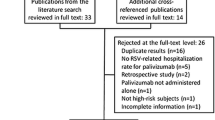Abstract
Background
Palivizumab has proven efficacy for prophylaxis of respiratory syncytial virus (RSV) in infants with prematurity or congenital heart disease. Despite a paucity of data, palivizumab is sometimes used to prevent progression when high-risk patients present with upper respiratory tract infection (URTI) due to RSV, or as therapy when any patients present with severe lower respiratory tract infection (LRTI) caused by RSV.
Methods
A systematic review of the literatures on the use of palivizumab as therapy for RSV was conducted. The primary outcomes were progression from URTI to LRTI and survival rates. Secondary outcomes were adverse events due to palivizumab, serum palivizumab level, and RSV concentration in respiratory secretions.
Results
The search yielded 1 case report, 4 case series, and 2 randomized controlled trials (RCTs) with a total of 136 adults and children. The RCTs were not powered to look at clinical outcomes. By combining all reported clinical outcomes, 3 (12%) of 25 patients with URTI who were given palivizumab died of RSV and 5 of 88 patients with LRTI at the time of treatment died of RSV (6%). Palivizumab levels appeared to be adequate for at least 3 weeks of intravenous injection at 15 mg/kg. The therapy resulted in decreased RSV concentrations in tracheal secretions.
Conclusion
Larger RCTs will be required before palivizumab can be recommended as therapy for RSV in any clinical setting.
Similar content being viewed by others
References
Whimbey E, Englund JA, Couch RB. Community respiratory virus infections in immunocompromised patients with cancer. Am J Med 1997;102(3A):10–18; discussion 25–26.
Robinson RF. Impact of respiratory syncytial virus in the United States. Am J Health Syst Pharm 2008;65(23 Suppl 8):S3–S6.
Committee on Infectious Diseases. From the American Academy of Pediatrics: policy statements—Modified recommendations for use of palivizumab for prevention of respiratory syncytial virus infections. Pediatrics 2009;124: 1694–1701.
The IMpact-RSV Study Group. Palivizumab, a humanized respiratory syncytial virus monoclonal antibody, reduces hospitalization from respiratory syncytial virus infection in high-risk infants. Pediatrics 1998;102:531–537.
Feltes TF, Cabalka AK, Meissner HC, Piazza FM, Carlin DA, Top FH Jr, et al. Palivizumab prophylaxis reduces hospitalization due to respiratory syncytial virus in young children with hemodynamically significant congenital heart disease. J Pediatr 2003;143:532–540.
Rodriguez WJ, Gruber WC, Welliver RC, Groothuis JR, Simoes EA, Meissner HC, et al. Respiratory syncytial virus (RSV) immune globulin intravenous therapy for RSV lower respiratory tract infection in infants and young children at high risk for severe RSV infections: Respiratory Syncytial Virus Immune Globulin Study Group. Pediatrics 1997;99:454–461.
Rodriguez WJ, Gruber WC, Groothuis JR, Simoes EA, Rosas AJ, Lepow M, et al. Respiratory syncytial virus immune globulin treatment of RSV lower respiratory tract infection in previously healthy children. Pediatrics 1997;100:937–942.
Malley R, DeVincenzo J, Ramilo O, Dennehy PH, Meissner HC, Gruber WC, et al. Reduction of respiratory syncytial virus (RSV) in tracheal aspirates in intubated infants by use of humanized monoclonal antibody to RSV F protein. J Infect Dis 1998;178:1555–1561.
Boeckh M, Berrey MM, Bowden RA, Crawford SW, Balsley J, Corey L. Phase 1 evaluation of the respiratory syncytial virus-specific monoclonal antibody palivizumab in recipients of hematopoietic stem cell transplants. J Infect Dis 2001;184:350–354.
Banna GL, Aversa SM, Cattelan AM, Crivellari G, Monfardini S. Respiratory syncytial virus-related pneumonia after stem cell transplantation successfully treated with palivizumab and steroid therapy. Scand J Infect Dis 2004;36:155–157.
Sáez-Llorens X, Moreno MT, Ramilo O, Sánchez PJ, Top FH Jr, Connor EM, et al. Safety and pharmacokinetics of palivizumab therapy in children hospitalized with respiratory syncytial virus infection. Pediatr Infect Dis J 2004;23:707–712.
Chávez-Bueno S, Mejías A, Merryman RA, Ahmad N, Jafri HS, Ramilo O. Intravenous palivizumab and ribavirin combination for respiratory syncytial virus disease in high-risk pediatric patients. Pediatr Infect Dis J 2007;26:1089–1093.
de Fontbrune FS, Robin M, Porcher R, Scieux C, de Latour RP, Ferry C, et al. Palivizumab treatment of respiratory syncytial virus infection after allogeneic hematopoietic stem cell transplantation. Clin Infect Dis 2007;45:1019–1024.
Liu V, Dhillon GS, Weill D. A multi-drug regimen for respiratory syncytial virus and parainfl uenza virus infections in adult lung and heart-lung transplant recipients. Transpl Infect Dis 2010;12:38–44.
Zybak J, Kassur-Siemienska B, Milczewska J, Wieteska-Klimczak A. The use of palivizumab in the treatment of a child with lower respiratory tract infection caused by respiratory syncytial virus—a case report. Pediatria Polska 2007;82:250–253.
Stacy T, Connaghan DG, Holland HK. Empiric treatment of respiratory syncytial virus infection in adult stem cell transplant recipients with ribavirin and palivizumab. Blood 2001;96: PART II, pp. 343b.
Cheng FW, Lee V, Shing MM, Li CK. Prolonged shedding of respiratory syncytial virus in immunocompromised children: implication for hospital infection control. J Hosp Infect 2008; 70:383–385.
Peck AJ, Englund JA, Kuypers J, Guthrie KA, Corey L, Morrow R, et al. Respiratory virus infection among hematopoietic cell transplant recipients: evidence for asymptomatic parainfluenza virus infection. Blood 2007;110: 1681–1688.
Schiffer JT, Kirby K, Sandmaier B, Storb R, Corey L, Boeckh M. Timing and severity of community acquired respiratory virus infections after myeloablative versus non-myeloablative hematopoietic stem cell transplantation. Haematologica 2009;94:1101–1108.
Prescott WA Jr, Doloresco F, Brown J, Paladino JA. Cost effectiveness of respiratory syncytial virus prophylaxis: a critical and systematic review. Pharmacoeconomics 2010;28:279–293.
Lagos R, DeVincenzo JP, Muñoz A, Hultquist M, Suzich J, Connor EM, et al. Safety and antiviral activity of motavizumab, a respiratory syncytial virus (RSV)-specific humanized monoclonal antibody, when administered to RSV-infected children. Pediatr Infect Dis J 2009;28:835–837.
Federal Drug Advisory, 2010. http://www.fda.gov/downloads/AdvisoryCommittees/CommitteesMeetingMaterials/Drugs/AntiviralDrugsAdvisoryCommittee/UCM213827.pdfref (accessed August 17, 2010).
Author information
Authors and Affiliations
Corresponding author
Rights and permissions
About this article
Cite this article
Hu, J., Robinson, J.L. Treatment of respiratory syncytial virus with palivizumab: a systematic review. World J Pediatr 6, 296–300 (2010). https://doi.org/10.1007/s12519-010-0230-z
Received:
Accepted:
Published:
Issue Date:
DOI: https://doi.org/10.1007/s12519-010-0230-z




